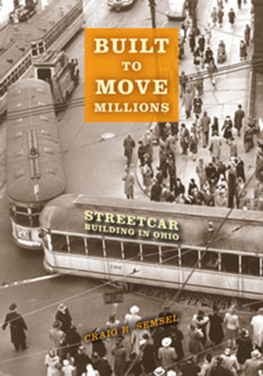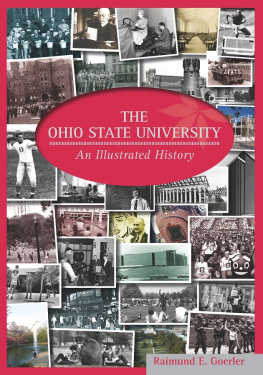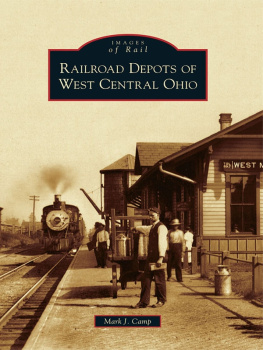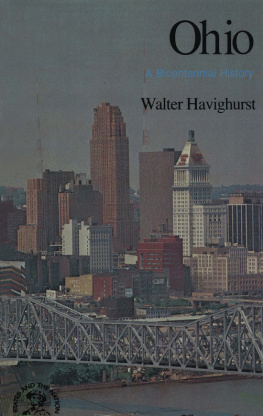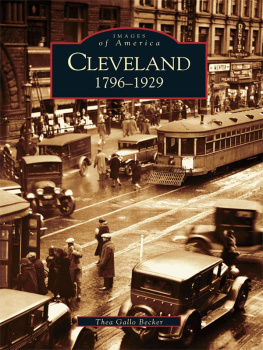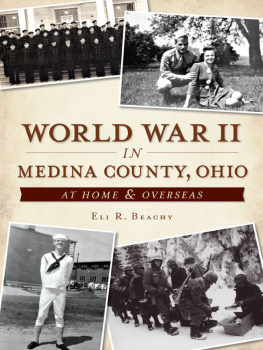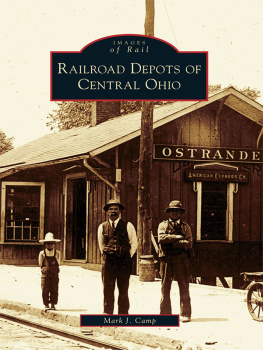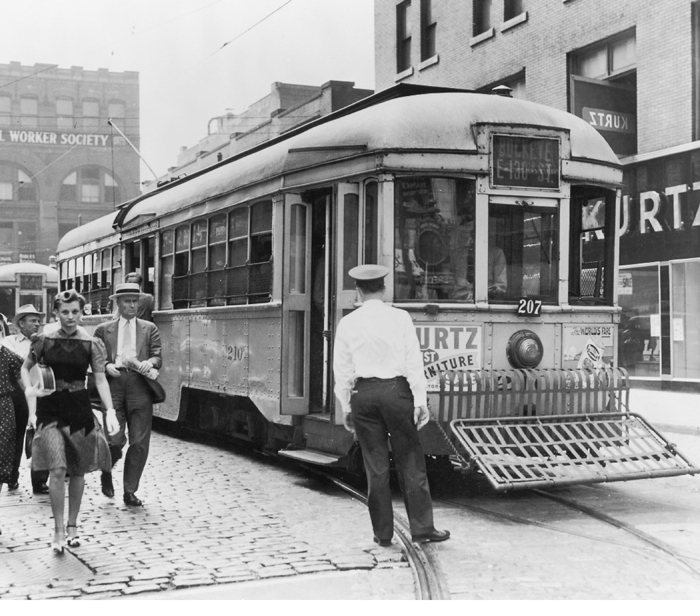Built to
Move
Millions
RAILROADS PAST AND PRESENT
George M. Smerk, editor
Built to
Move
Millions
STREETCAR
BUILDING IN OHIO
CRAIG R. SEMSEL
Indiana University Press Bloomington & Indianapolis
This book is a publication of
Indiana University Press
601 North Morton Street
Bloomington, IN 47404-3797 USA
http://iupress.indiana.edu
| Telephone orders | 800-842-6796 |
| Fax orders | 812-855-7931 |
| Orders by e-mail | iuporder@indiana.edu |
2008 by Craig R. Semsel
All rights reserved
No part of this book may be reproduced or utilized in any form or by any means, electronic or mechanical,including photocopying and recording, or by any information storage and retrieval system,without permission in writing from the publisher. The Association of American UniversityPresses Resolution on Permissions constitutes the only exception to this prohibition.
The paper used in this publication meets the minimum requirements of American NationalStandard for Information SciencesPermanence of Paper for Printed Library Materials, ANSIZ39.48-1984.
Manufactured in the United States of America
Library of Congress Cataloging-in-Publication Data
Semsel, Craig R.
Built to move millions: streetcar building in Ohio / Craig R. Semsel.
p. cm.(Railroads past and present)
Includes bibliographical references and index.
ISBN 978-0-253-34985-9 (cloth: alk. paper) 1. Street-railroadsOhioHistory. I. Title.
TF724.O3S46 2008
625.6609771dc22
2007031480
1 2 3 4 5 13 12 11 10 09 08
To Charles A. Knapp, for that first streetcar ride,
and to Violet E. Knapp, for all of the streetcar rides that followed.
CONTENTS
In a very real sense, this book is the product of many individuals and not solely the author whose name appears on the cover. Without their help, this book would never have happened. As I pore over the correspondence, e-mails, and reams of notes that were generated during this books gestation, certain names and organizations stand out. For those I may have missed, I offer my sincerest apologies.
This book started and ended at the Cleveland Public Library. For anyone who has not had the privilege of conducting research there, I would encourage him or her to do so. Throughout the research, revision, and illustration stages of this project, the staff at CPL lived up to the term professionalism. A special thank-you should be extended to the staff of the Microfilm Department, which endured countless trips into the CPL basement to unearth the various reels of industry journals and transactions that are kept there. When hard copies of the trade literature were required, the Science and Technology and Business Departments never failed to answer the call. The Photograph Department must have set a record for the speed with which they located and reproduced the images of local streetcar activity.
At Case Western Reserve University in Cleveland, Dr. Kenneth Ledford was a patient and helpful mentor. On more than one occasion he settled my nerves and explained the mysteries of how books get published. His good humor, pithy insights, and general encouragement were invaluable.
Numerous museums contributed photographs, provided access to artifacts, and offered plenty of information. By far the greatest help came from the Branford Electric Railway Association in Connecticut, which operates the Shoreline Trolley Museum. Archivist and curator Michael Schreiber found plenty of excellent photographs of Ohio-built streetcars, while BERA president William Wall spent what had to be the hottest, most humid day of the year leading me and my wife through basements, barns, and yard trackage to find examples of Ohio-built streetcar components and other items needed to illustrate the various topics covered in this book. Fred Sherwood also helped us gain better access to some of the museums exhibits.
The Indiana Historical Society, where most of the Cincinnati Car Companys photographs are preserved, rivaled the CPL in terms of its professionalism and general helpfulness. Susan Sutton, coordinator of visual references, was a plea sure to work with. She and her assistants came through in the eleventh hour to find the right photograph over the telephone when I had written down the wrong folder number in my notes. To Susan and all of the staff at IHS, thank you.
Surviving Barney & Smith interurbans are relatively rare, but a fine example is undergoing restoration in Coopersville, Michigan. James Budzinsky, president and curator of the Coopersville Area Historical Society and Museum, took me on a tour of this car. Housed in an old interurban electrical substation, the museum still captures the feel of the interurban era.
In West Henrietta, New York, the New York Museum of Transportation also has a number of useful cars and artifacts in its collection, as well as one of the most scenic settings for an electric railway museum. Charles Lowe and James Dierks, secretary of the board of trustees, were incredibly helpful in providing information on streetcar construction as well as providing access to areas of the museum that are not normally open to the public.
In Ohio, Dayton History, the organization that operates Carillon Park, went above and beyond the call to allow my wife and me to photograph some of their collection. Amanda Lakatos, communications manager, did a great job of arranging for our visit to Carillon, while education director Alex Heckman made sure that my wife and I had access to everything we needed. Docent Harold Boat was also a great help in an earlier visit to Carillon, especially in providing stories and information that otherwise would not have made it into the book.
In Columbus, the Ohio Railway Museum holds a number of rare artifacts. I thank museum president William Wahl for allowing me to use some of the museums postcard images.
Closer to home, useful artifacts were discovered at the Northern Ohio Railway Museum at Chippewa Lake. Fund-raising director Steven Heister took time out of preparing for an open house event to take my wife and me through cars and storage areas to ensure we got the right photographs.
With the exception of photographs provided by CPL and IHS, many of the photographs appearing in this book required professional assistance in their development, as well as substantial coaching as to how to take them in the first place. Amanda Yeaton at Dodd Camera, Westlake, was in on the photographic portion of this project from the beginning, and she helped my wife and me avoid costly (not to mention embarrassing) mistakes. She performed wonders with a number of photographic mediums.
Edward Siplock was helpful in more ways than he will ever know. A gifted researcher and genealogist, Ed was working on his own project at the CPL while I was working on this one. Conversation over numerous lunches in downtown Cleveland made an arduous task more pleasant than it otherwise would have been. (For the record, Eds book came out before this one.)
At Indiana University Press, series editor George Smerk has been a constant source of encouragement and advice. Without him, this book would never have happened. Linda Oblack has also done much to demolish the stereotype of nasty editors and has been a plea sure to work with.

